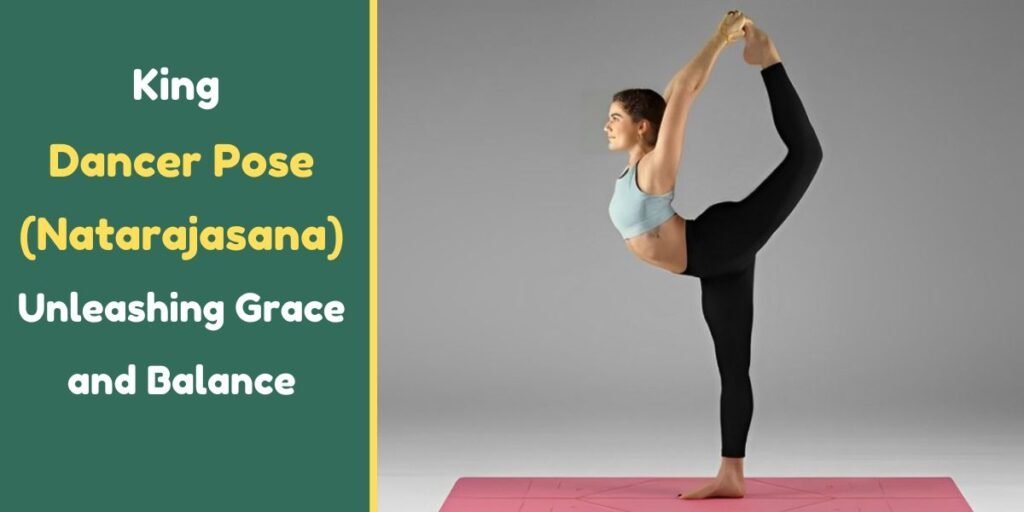Introduction
When thinking about the wonderful motivations to start doing yoga, many people prioritize physical aims such as enhancing flexibility and achieving better balance. Imagine a graceful and strong pose that helps you find balance both in your body and mind. That’s exactly what the King Dancer Pose, or Natarajasana, is all about.
Performing the King Dancer Pose looks Just like a dancer; you’ll stretch and flow, creating a beautiful shape that brings wonderful health benefits. This pose has a special meaning, too – it’s like embodying the dance of Lord Shiva, the Adi Yogi, who is the divine dancer and the source of all creation. So, get ready to fully understand this asana, practice it and experience its beauty and goodness for yourself!
The History and Mythology behind King Dancer Pose (Natarajasana)
To truly understand the King Dancer Pose or Natarajasana, we must know its historical and mythological roots. The name “Natarajasana” is derived from a combination of three Sanskrit words where “Nata,” meaning dance, “raja,” meaning king, and “asana,” refers to posture.
According to Hindu mythology, Lord Shiva, the supreme god of destruction and transformation, is revered as the divine dancer who performs the cosmic dance of creation, preservation, and destruction. This graceful pose imitates the form of Shiva’s dancing pose and represents the harmony of opposites – the balance between masculine and feminine energies, life, and death.
Preparing for King Dancer Pose (Natarajasana): Warm-up and Alignment
Before attempting Natarajasana, it’s crucial to prepare your body with a proper warm-up. Engage in some gentle stretching exercises to loosen up the hips, shoulders, and quadriceps. A well-prepared body is less prone to injury during the practice of this complex pose.
Warm-up Routine
- Neck Rotations: Gently rotate your neck clockwise and then counterclockwise to release tension in the neck and shoulders.
- Shoulder Rolls: Roll your shoulders forward and backward in a circular motion to increase mobility.
- Hip Opening Stretches: Perform hip-opening poses like Baddha Konasana (Butterfly Pose) or Pigeon Pose to open up the hips.
- Quadriceps Stretch: Stand straight, bend one knee, and hold the ankle of that leg with your hand. Bring your heel toward your glutes, feeling the stretch in your quadriceps. Switch sides and repeat.

Aligning Your Body
- Starting Position:Stand tall in Tadasana (Mountain Pose), with your feet hip-width apart and arms by your sides.
- Weight Distribution:Shift your weight onto your left foot.
- Balance and Focus:Fix your gaze on a steady point before you to enhance concentration and balance.
The Asana: Executing King Dancer Pose (Natarajasana)
Now that you are warmed up and aligned, it’s time to get into the majestic Natarajasana. Follow these steps to perform the pose with poise and elegance.
- Lift Your Right Leg:Bend your right knee and reach your right hand back to hold the inner arch of your right foot.
- Extend Your Left Arm:Raise your left arm forward and parallel to the ground, keeping it shoulder height.
- Balance and Lift:As you inhale, lift your right foot off the ground and extend your leg backward, parallel to the ground.
- Archer’s Bow Pose:Gradually kick your right foot into your hand, pushing your foot back against your palm. This action will lift your torso and open your chest, resembling an archer’s bow.
- Engage Your Core:To maintain balance, engage your core muscles and keep your pelvis squared.
- Find Stability: Hold the pose for 5 to 10 breaths, maintaining a steady breath and a focused mind.
- Release and Repeat: Slowly release the pose and return to Tadasana. Repeat the pose on the opposite side, lifting your left leg.

Benefits of King Dancer Pose (Natarajasana)
Natarajasana offers many benefits for the mind, body, and soul. Incorporating this graceful pose into your yoga practice can:
- Enhance Balance: Natarajasana challenges your balance and helps improve physical and mental stability.
- Strengthen Muscles: The pose targets and strengthens the legs, ankles, thighs, shoulders, and core muscles.
- Flexibility and Stretching: It stretches the shoulders, chest, quadriceps, and abdomen, promoting flexibility.
- Improved Concentration: The one-pointed focus required to maintain balance in Natarajasana enhances concentration and mindfulness.
- Emotional Release: The heart-opening nature of the pose can release emotional tension and promote a sense of joy and liberation.
- Posture Correction: Regular practice of Natarajasana can help correct rounded shoulders and poor posture.
Read More: What is Tree Pose (Vrikshasana)? – Rooting Yourself in Stability and Balance
Precautions and Modifications
As with any yoga pose, Natarajasana should be practiced cautiously, especially if you have certain health conditions. Here are some precautions and modifications to consider:
- Injury or Pain:Avoid Natarajasana if you have ankle, knee, or back injuries or pain.
- Beginners: If you’re new to yoga or balance poses, start with a modified version using a strap to hold your foot.
- Props:Utilize props like a wall or a chair for support until you gain enough balance and confidence.

Conclusion
To deepen your understanding and mastery of Natarajasana, consider joining our 200 Hour Yoga Teacher Training in Rishikesh, India. Surrounded by the serene Himalayan landscape, our expert instructors will guide you through a comprehensive curriculum that explores the physical, mental, and spiritual dimensions of yoga. Learn how to teach and practice Natarajasana with precision and confidence, and discover the transformative power of yoga to harmonize body, mind, and spirit.




